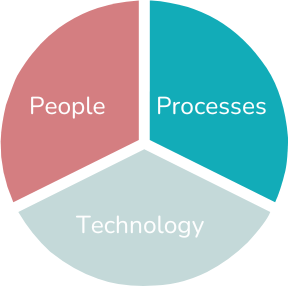Data Readiness Assessment [Self-Assessment Test]
What is Data Readiness?
Data readiness is the ability of your organisation to effectively manage, analyse, and use data to achieve business goals. It ensures that your tools, processes, and teams are aligned to support advanced initiatives like AI and business intelligence.
Take the Free Data Readiness Assessment Now: Evaluate your data maturity and get a personalised roadmap to success
Unstructured Data → Failure to Use AI
Many organisations struggle with:
- Fragmented data tools that do not integrate seamlessly
- Unclear data strategies that slow decision-making
- Outdated technology that hinders AI adoption
A recent report by MIT Technology Review Insights, in partnership with Snowflake, found that 78% of companies are not fully prepared to support AI deployment. Without a strong data foundation, four out of five businesses are unable to harness the productivity and innovation benefits promised by Gen AI.
This guide will show you how to evaluate your data maturity and create a strategy that aligns with your business goals.
What is Data Readiness?
Data readiness refers to your organisation’s ability to:
- Collect and store data efficiently
- Ensure data quality and governance
- Leverage data for AI, analytics, and business intelligence
Quick Data Readiness Checklist:
1. People – Building a Data-Driven Culture
For an organisation to be truly data-ready, it needs skilled team who can manage, interpret, and act on data insights. The effectiveness of a data strategy depends not just on tools and infrastructure but on the people responsible for implementing and maintaining it.
Key considerations:
- Data Literacy: Does your workforce understand how to interpret and apply data insights in decision-making?
- Roles & Responsibilities: Are clear data governance roles defined? Does your organisation have data analysts, engineers, and scientists in place?
- Collaboration: Are business teams and IT aligned on how data should be used?
- Training & Development: Does your organisation invest in upskilling employees to work with modern data technologies and AI-driven insights?
Example:
A marketing team might need training on how to use a Power BI dashboard to extract insights rather than relying on data teams for reports.
- Processes – Establishing Strong Data Governance
Data readiness requires well-defined processes to ensure data is collected, stored, managed, and accessed efficiently. Without structured processes, even the best data tools will fail to deliver value.
Key considerations:
- Data Collection & Quality: How is data being collected? Are there mechanisms in place to ensure data accuracy, consistency, and completeness?
- Data Governance & Compliance: Are there policies for data security, privacy, and regulatory compliance (e.g. GDPR)?
- Workflow Automation: Are manual processes minimised through automation to improve efficiency and reduce errors?
- Data Accessibility: Is the right data available to the right people at the right time?
Example:
A finance team should have controlled access to revenue and expenditure reports, while a sales team may only need access to lead conversion data.
- Technology – Building a Scalable Data Infrastructure
The right technology stack enables organisations to process and analyse data at scale while ensuring reliability, security, and cost-effectiveness. A well-optimised data infrastructure supports AI and analytics by providing fast, secure, and integrated access to structured and unstructured data.
Key considerations:
- Cloud vs. On-Premises: Is your data stored in a scalable cloud platform (e.g. Azure, AWS, Databricks) or restricted to legacy on-premises systems?
- Integration & Interoperability: Can different data systems (CRM, ERP, analytics platforms) communicate with each other?
- Data Processing & Analytics: Is your organisation using tools such as Databricks, Microsoft Fabric, and Power BI to process large datasets efficiently?
- Security & Compliance: Are security measures like data encryption, access controls, and audit logs in place?
Example:
Atlas Insurance’s migration to a cloud-based solution resulted in 83% data processing reduction. Atlas faced limitations with on-premises data cubes, which resulted in slow data processing and limited scalability of operations. To overcome this, Eunoia migrated their data infrastructure to a cloud-based solution using Power BI and Microsoft Azure.
Why It Matters To Data Readiness:
- A data-ready organisation can implement AI and machine learning faster
- It ensures data-driven decision-making at every level
- It eliminates inefficiencies and reduces costs associated with poor data management
Why Conduct a Data Readiness Assessment?
Benefits of a Data Readiness Assessment
- Identify gaps – Understand weaknesses in your data infrastructure, processes, and governance
- Streamline strategy – Prioritise key actions to align data efforts with business goals
- Prepare for AI – Ensure your data is structured, accessible, and optimised for AI initiatives
Tools and Technologies to Improve Data Readiness
- Databricks – Scalable data processing for AI and analytics
- Microsoft Azure – Secure cloud storage and integration
- Power BI – Real-time data visualisation and reporting
- Microsoft Fabric – Unified platform for structured and unstructured data
Read more about Data Strategy.
Case Study: How NetRefer’s Data Transformation Reflected on AI Capabilities
The Problem
NetRefer, a global leader in affiliate marketing, relied on legacy systems that created performance bottlenecks, high operational costs, and limited scalability.
The Solution
Modernising the Data Platform
Eunoia built a scalable data management platform using Databricks and the Medallion Architecture, enabling:
- A transition from SQL Server to a cloud-native solution for improved performance
- Decoupling legacy systems to enhance scalability and flexibility
- Optimising infrastructure costs, reducing operational expenses
Implementing AI-Powered Insights
To provide NetRefer’s clients with a competitive advantage, Eunoia deployed a GPT-powered natural language processing (NLP) solution, allowing users to:
- Ask questions in plain English and receive instant, data-driven insights
- Analyse marketing data without requiring advanced technical expertise
This enabled easy access to data and informed decisions.
Results & Impact
Reduction of cloud costs through cloud optimisation with Databricks
Easy and accurate data analysis with help of AI, an NLP-driven solution
Industry-first innovation, positioning NetRefer as the leading AI-powered affiliate marketing platform
By aligning business and data goals, NetRefer successfully future-proofed its data infrastructure, enabling scalability, cost efficiency, and AI-driven decision-making.




